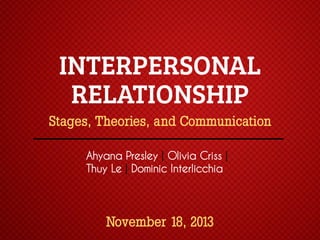
Interpersonal Relationship
- 1. Stages, Theories, and Communication Ahyana Presley | Olivia Criss | Thuy Le | Dominic Interlicchia November 18, 2013
- 2. • Perceptual • Interactional Contact EXIT • Testing • Intensifying Involvement EXIT Intimacy EXIT • Interpersonal Commitment • Social Bonding Repair Deterioration EXIT Dissolution • Intrapersonal Repair • Intrapersonal Dissatisfaction • Interpersonal Separation • Interpersonal Repair • Interpersonal Dissatisfaction • Social/ public Separation
- 3. Perceptual • See, hear, read a message • View a photo or video • Smell the person Elements to form a mental & physical picture along with gender, age, beliefs, values, height, etc. Interactional • Superficial • Relatively impersonal Basic information is exchanged & preliminary to more involvement with the person
- 4. Testing Whether your initial judgment is true the sense of mutua lity of being con nected develops • What school are you attending? • What are you majoring in? Intensifying Reveal more of yourself, amp up your affections to move to next level of the relationship Gifts, cards, flowers, flirting, or becoming sexually intimate
- 5. Flirting DO’S DON’TS Compliment Inappropriate Compliment Introduce yourself Drawn-out introduction Make eye contact Blink a lot or stare profusely
- 6. Interpersonal Commitment Committing yourself further and establishing a deeper connection with the person who becomes your best or closest friend Two people agree to be committed to one another in a confidential manner Social Bonding Public “outing” of the commitment made by two people, usually in front of family and friends. Unit is formed. http://www.youtube.com/ watch?v=Ke2Ho4JqgsI
- 7. Intrapersonal Dissatisfaction Occurs when the bond between two individuals becomes weak Everyday interactions become unsatisfying and the future begins to look bleak unlike before Interpersonal Dissatisfaction Spend less free time together, withdraw and grow farther apart
- 8. Intrapersonal Repair Interpersonal Repair Analyze what went wrong and consider ways of fixing the problems Both partners will discuss, the problem, what changes they would like to see and what both parties are willing to do
- 9. Interpersonal Separation Bonds are broken and the unit reverts back to individuals Living separate lives, possibly in different apartments Social/Public Separation Comes in the form of divorce if a married couple or avoidance and the return of the “single life” if in a committed relationship
- 10. Vertical Arrows: move to a more or less intense stage Repair EXIT Involvement EXIT Intimacy Self-reflexive Arrows: stabilization Contact EXIT Deterioration Exit Arrows: each stage presents an exit strategy Dissolution EXIT
- 11. Relationship Liscence Turning Points Important events that can change the direction of the relationship and create consequences for the individuals involved Permission to break some relationship rule as a result of your stage in the relationship • Intimate VS non-intimate relationships • Can be reciprocal • Varies across cultures • Can be negotiated mostly nonverbally and in small increments • Mostly positive but can be negative • Vary with culture • Varies with the stage of the relationship
- 12. 5 Factors Similarity Proximity People form relationships on the basis of attraction Reinforcement Physical Attractiveness Personality
- 13. Friendship Rules Relationship are held together by an adherence of certain rules Romantic Rules Family Rules Workplace Rules
- 14. Common Internal Tensions Closeness & Openness Autonomy & Connection A person engaged in a relationship experiences internal tensions causing the relationship to be in a constant state of flux Novelty & Predictability
- 15. WHY relationship s develop? WHAT happens when they develop? BREADTH how many topics are talked about DEPTH the degree to which you penetrate the core of the other individual
- 18. Relatively proportional COSTS REWARDS Equitable relationships = Greater Satisfaction Inequitable relationships = Greater Dissatisfaction
- 20. To be autono -mous To be thought of highly + Respect Contribute Acknowledge - Rules violated = Relationships deteriorate Rules maintained = Relationships maintained
- 21. Be nice Share joint activities Communicate Be open Be positive Focus on Self-improvement Give assurances Be empathic
- 22. Communication Patterns Withdrawal Decline in self-disclosure Deception Positive messages decrease Negative messages increase
- 23. Strategies of disengagement Positive tone to preserve relationship Justification to explain breakup Negative identity management De-escalation to reduce intensity
- 24. Dealing with a break-up Break lonelinessdepression cycle Take time out Bolster self-esteem Remove uncomfortable relationship symbols Be mindful of your relationship patterns
- 25. Interpersonal Repair R Recognize the problem E Engage in productive conflict resolutions P Pose possible solutions A Affirm each other I Integrate solutions into normal behavior R Risks
- 26. Intrapersonal Repair Stimulus-Response View Criticis m Attack Criticism Attack Circular View Attack Criticism Criticism Attack Remember punctuation
